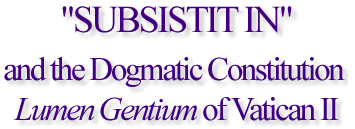SI SI NO NO "SUBSISTIT IN" & THE DOGMATIC CONSTITUTION LUMEN GENTIUM OF VATII DECEMBER 1994

December 1994 No. 11

OUR READERS WRITE
We received the following letter from Germany:
The Second Vatican Council was searching for a new definition of the Catholic Church. Was this definition to become a new dogma, since the constitution [Lumen Gentium] is called "dogmatic"? Opinions differed, and discussions on the matter were long and stretched out. On the one hand, we did not want to diverge from the truth, and on the other hand we did not want to offend non-Catholic Christians.
At the Council, one of the Protestant observers made the following proposition to one of the Fathers: Christi Ecclesia....subsistit in Ecclesia catholica (Lumen Gentium, 8). The Father accepted this proposition, and it was in this manner that a Protestant idea became a Catholic one, and the opinion of a non-Catholic Christian was introduced into Catholic ecclesiology - into the very definition of the Church, into the heart of the famous dogmatic constitution. Therefore, the basic definition of the Church was formulated not by one of its own theologians (like de Franzelin during Vatican I), but by someone from the non-Catholic world.
It was during the time of the Council that this Protestant minister told me about these events. We are still bound by close ties of friendship today.
Name withheld by request
OUR COMMENTARY
This testimony is in perfect accord with what Giandomenico Mucci, S.J., wrote in the editorial section of La Civilta Cattolica, December 5, 1988 (see also Courrier de Rome #93 [283], June 1988: "Subterfuge in the Face of Revealed Truth: the Subsistit in and Lumen Gentium).
This Jesuit admitted that there was a "striking difference" between the Council's document and previous Catholic ecclesiology:
It is one thing to say that the Mystical Body of Christ and the Catholic Church are perfectly identical; to state, consequently and necessarily, that the Roman Catholic Church is the only Church of Christ. It is another thing to say that the Church of Christ subsists in the Catholic Church (emphasis added by sì sì no no).
It seems, however, that he was able to justify this striking difference: having gone "from one definition (est) to another (subsistit in) was done for ecumenical purposes." And, he added, "during the conciliar discussions, concern for ecumenism undoubtedly grew, and quite noticeably at that." This concern for ecumenism found its way in through the more or less secret work of the "new theologians," "separated brothers," and "observers," all of them manipulators of the Council.
When Pius IX summoned the First Vatican Council, he exhorted non-Catholics to profit from it in order to "liberate themselves from a state in which they could not be sure of gaining salvation. " Dr. Cumming from Scotland asked him if Protestants could present their arguments to the Council. The Pope answered that:
...(T)he Church could not allow for these errors to be put up for discussion again, since they had already been examined, judged and condemned (Papal brief Per Ephemerides Accepimus to Card. Manning, September 4, 1869).
The re-discussion of errors is exactly what was allowed behind the scenes in Vatican II. This Council is proving itself to be a great fraud, and will be known to history as such.
sì sì no no, July-August 1994
Views: 86
Tags:
© 2025 Created by Dawn Marie.
Powered by
![]()
You need to be a member of Crusaders of the Immaculate Heart to add comments!
Join Crusaders of the Immaculate Heart